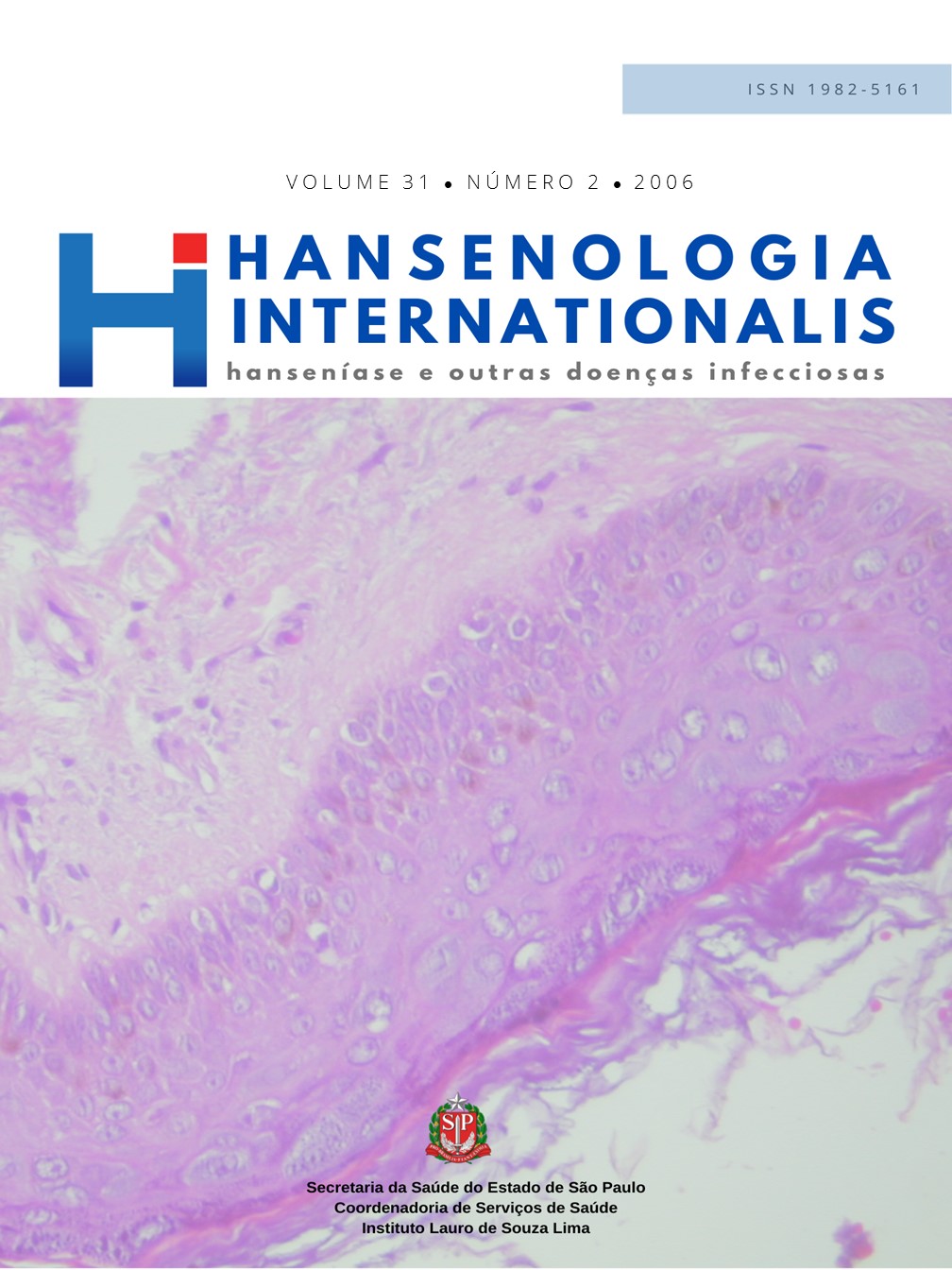Abstract
In the attempt to elucidate the mechanisms that direct to the clinical forms of leprosy, HLA complex has been widely studied. Positive associations of the alelles were observed for HLA-DR2 and HLA-DR3 with the tuberculoid form (HT) and alelle HLA-DQ1 with the lepromatous form (HV). In relation to HIV, HLA-B35 and HLA-Cw4 class I alleles seem to be more strongly associated with immunological deterioration and accelerated aids progression. Class I HLA-A1, HLA-B8, HLA-B27, HLA-Cw7 and class II alleles, HLA-DR3 and HLA-DQ2 are associated with long-term nonprogressive disease. Because no literature data has described the participation of alelles HLA in individuals co-infected with leprosy and HIV, the present study aimed at evaluating in class I ( locus A,B,C) and class II (locus DR and DQ) HLA frequencies in co-infected patients, attended at the Instituto Lauro
of Souza Lima, Bauru. It was possible to observe that presence of alelles associated with fast progression of aids did not infl uence the clinical spectrum of leprosy. Although HIV infection intensively affects the immune system, it seems not to lead to leprosy multibacillary forms. Since co-infection HIV/M.leprae is an important event in endemic areas for both diseases such as Brazil, more patients should be evaluated in order to increase the signifi cant of these fi ndings.
References
2 Andrade V, Alves TM, Avelleira JCR, Bayona M. Prevalência de HIV-1 em pacientes de hanseníase no Rio de Janeiro. Hansen int 1996; 21(1):22-33.
3 Lucas S. Human immunodefi ciency vírus and leprosy. Lepr rev 1993; 64:97-103.
4 Opromolla DVA, Tonello CJS, Fleury RN. Hanseníase dimorfa e infecção pelo HIV (aids). Hansen int 2000; 25(1):54-9.
5 Sampaio EP, Caneshi JRT, Nery JAC, Duppre NC, Pereira GMB, Vieira LMM et al. Cellular Immune Response to Mycobacterium leprae infection in Human Immunodefi ciency Vírus-Infected Individual. Infect and Imun 1995; 63(5)1848-54.
6 Abbas AK, Lichtam AH, Pober JS. Cellular and molecular immunology. 4thed. New York: W.S.Saunders Co., 2000.
7 Munro A, Bright S. Products of the major histocompatibility complex and their relationship to the immune response. Nature 1976; 264:145-52.
8 Sasazuki T, Nishimura Y, Muto M, Ohta N. HLA-linked genes controlling immune response and disease susceptibility. Immunol Rev 1983; 70: 51-75.
9 Naik S. The Human HLA System. J Indian Rheumatol Assoc 2003; 11:79-83.
10 Klein J, Sato A. The HLA System. Review Articles. Advances in Immunology. The New England Journal of Medicine 2000; 343(11):782-6.
11 Ottenhoff THM. Immunology of leprosy. New developments. Trop Geogr Med. 1994;46(2):72-80.
12 Petzel-Erler ML. Genetics of the immune response and disease susceptibility. Cienc Cult (São Paulo) 1999; 51: 199-211.
13 Ustionowski AP, D Lawn S, Lockwood DNJ.Interactions betwen HIV infection and leprosy: a paradox. Lancet Infect Dis.2006;6:350-60.
14 Van Eden W, Mehra NK, Vaidya MC, D´Amarco J, Schreuder GMTh, Van Rood JJ. HLA and sporadic tuberculoid leprosy: a population study in Maharashta, India. Tissue antigens 1981; 18(3): 189-94.
15 Van Eden W, de Vries RR, D´Amaro J, Schreuder I, Leiker DL, Van Rood JJ. HLA-DR associated genetic control of the type of leprosy in a population from Surinam. Human Immunol. 1982; 4(4):343-50.
16 Izumi S, Sugiyama K, Matsumoto Y, Ohkawa S. Analysis of the immunogenetic background of Japanese leprosy patients by the HLA system. Vox sang 1982; 42(5): 243-7.
17 Ottenhoff THM, Gonzalez NM, De Vries RR, ConvitJ, Van Rood JJ. Association of HLA specifi city LB-E12 (MB1, DC1, MT1) with lepromatous leprosy in a Venezuelan population. Tissue antigens 1984; 24 (1): 25-9.
18 Carrington M, NelsonGW, Martins MP, Kissner T, Vlahov D, Goedert JJ, et al. HLA and HIV-1: Heterozygote Advantage and B35-CW4. Disadvantage. Science 12 march 1999. v 283.
19 Scherer A, Frater J, Oxenius A, Aguderlo J, Price DA, Günthard HF et al.. quantifi able cytotoxic T lymphocyte responses and HLA-related risk of progression to AIDS. PNAS 2004;101(33): 12266-70.
20 Kelleher AD, Long C, Holmes EC, Allen RL, Wilson J, Conlon C et al.. Clustered mutations in HIV-1 gag are consistently required for escape from HLA-B27-restricted cytotoxic T lymphocyte response. J Exp Med 2001;193(3): 375-85.
21 Dubey DP, Yunis I, Leslie CA, Mehta C, Yunis EJ. Homozygosity in the major histocompatibility complex region infl uences natural killer cell activity in man Eur. J. Immunol. 1987;17(1):61-66.
22 Miller SA., Dykes DD, Polesky HF. A simple salting out procedura for extracting DNA from human nucleated cells. Nucleic Acids. Res 1988; 16: 1215.

This work is licensed under a Creative Commons Attribution 4.0 International License.
